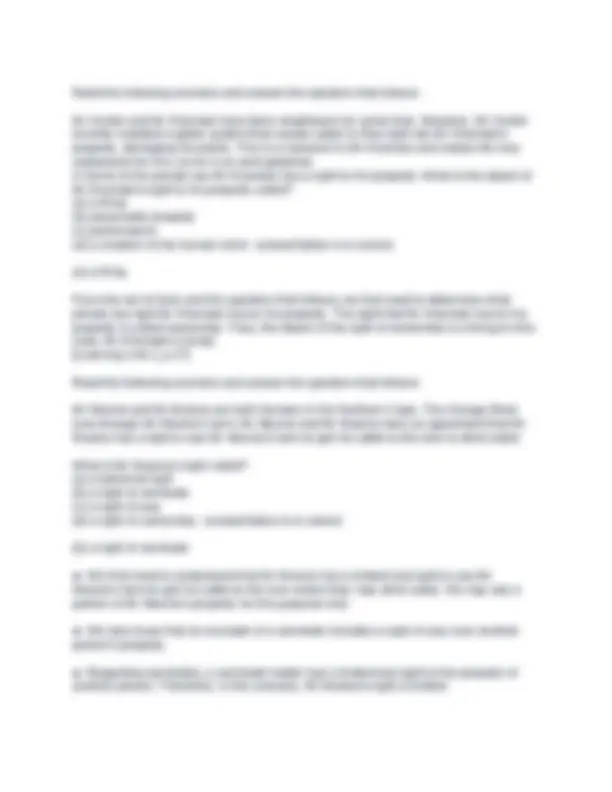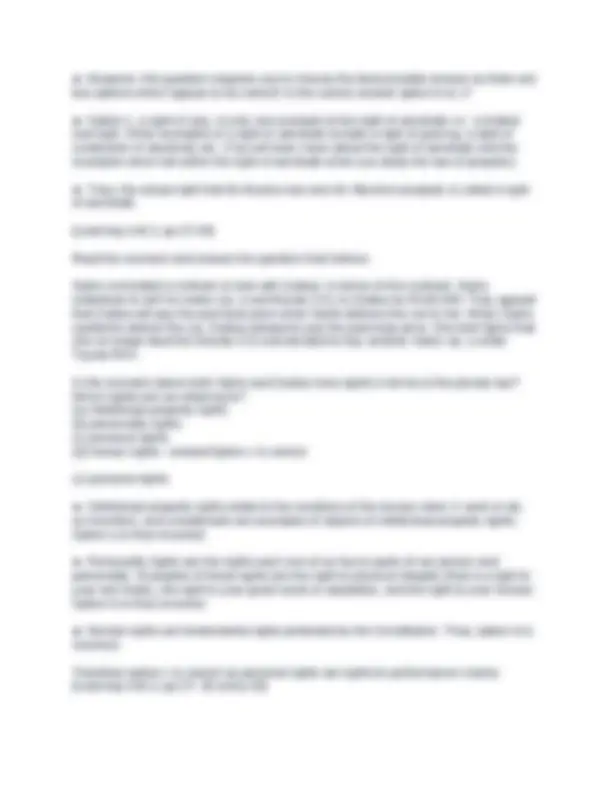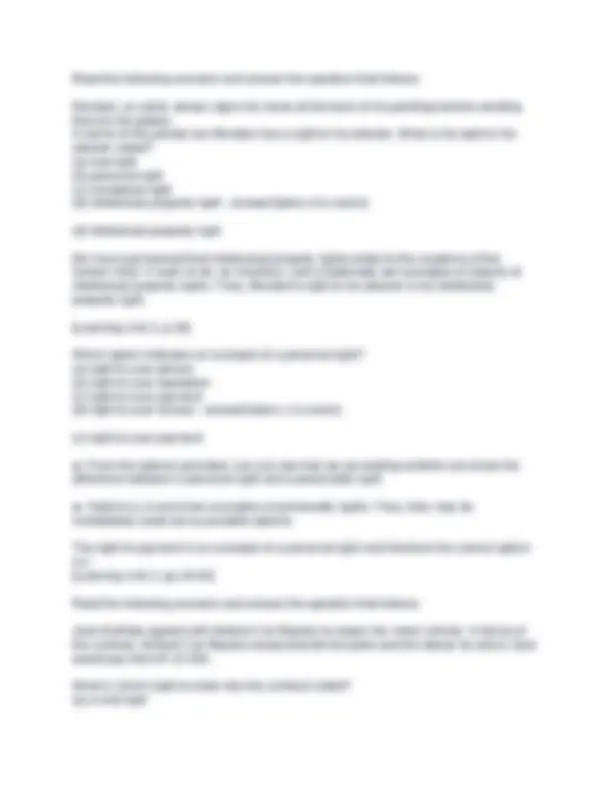





Study with the several resources on Docsity

Earn points by helping other students or get them with a premium plan


Prepare for your exams
Study with the several resources on Docsity

Earn points to download
Earn points by helping other students or get them with a premium plan
Community
Ask the community for help and clear up your study doubts
Discover the best universities in your country according to Docsity users
Free resources
Download our free guides on studying techniques, anxiety management strategies, and thesis advice from Docsity tutors
ILW1501 - Chapter 2 Questions and Answers Graded A+
Typology: Exams
1 / 6

This page cannot be seen from the preview
Don't miss anything!




Complete the following sentence by choosing the correct option: A right refers to... (a) a rule that regulates human behavior within our society. (b) the way people relate to (objects) things and to one another. (c) anything that is of economic or sentimental value to a person. (d) a rule that must be obeyed by all members of society. - answer Option b is correct. (b) the way people relate to (objects) things and to one another. ► We are left with option b, which is the correct option as a right refers to the way people relate to objects/things and to one another. [Learning Unit 2, pp 25-26] Every right concerns a dual relationship. Indicate which option reflects the two parts of this dual relationship correctly: (a) a relationship between the holder of a right and the object of a right (b) a relationship between a legal subject and a legal object (c) a relationship between a legal subject and legal object, and other legal subjects (d) a relationship between a legal subject and other legal subjects - answerOption c is correct. (c) a relationship between a legal subject and legal object, and other legal subjects This answer requires that you understand the two parts of the dual relationship specific to every right. Recall the example provided in Learning Unit 2: I have a right to my car, to my book, to the services of my employee, to the invention which I have patented, to delivery of the thing which you have sold me. I also have a right against the person who has sold me a car, against my employee who must provide me with his services, against all others who must respect my right to my car, my book, and so on. Thus, the dual relationship as regards a right reflects a relationship between a legal subject and legal object, and other legal subjects. [Learning Unit 2, p 26] Which of the following options does NOT relate to the term "legal subjects"? (a) natural and juristic persons (b) bearers of rights and duties
(c) persons who are subject to norms of the law (d) persons who are not under control of the law - answerOption d is correct. (d) persons who are not under control of the law Watch out for questions framed in the negative! This means that you need to find an option that does not relate to a specific term/concept. We know that a legal subject is a person who is subject to (or under the control of) the norms of the law and who also may be the bearer (holder) of rights and duties. A legal subject refers to a person which includes a natural and juristic person (for example, entities and companies). Thus, options a, b and c all relate to the term "legal subjects' and can be ruled out as possible options. [Learning Unit 2, p 26] Which of the following is NOT a legal object? (a) a company (b) a painting (c) a good name (d) a herd of cows - answerOption a is correct. (a) a company We have just learned that a legal subject includes a juristic person (Answer 3). Therefore, a company (which is a juristic person) is a legal subject and cannot be a legal object. Thus, as options b, c and d refer to legal objects, option a is the correct option. [Learning Unit 2, pp 26-27] Which of the following options about ownership is correct? (a) Ownership is a limited real right that cannot be limited. (b) Ownership is a real right over movable or immovable property. (c) Ownership does not include the owner's power to destroy his property. (d) Ownership does not include the owner's power to alienate his property. - answerOption b is correct. (b) Ownership is a real right over movable or immovable property. We know that when considering the right of ownership, the owner's powers to freely use, alienate and destroy the property he/she owns are the powers which form the content of the owner's real rights of ownership. Thus, options a, c and d are incorrect and can be ruled out as possible answers. As ownership is a real right over moveable or immoveable property, option b is the correct option. [Learning Unit 2, p 27]
► However, this question requires you to choose the best possible answer as there are two options which appear to be correct! Is the correct answer option b or c? ► Option c, a right of way, is only one example of the right of servitude i.e.: a limited real right. Other examples of a right of servitude include a right of grazing, a right of conduction of electricity etc. (You will learn more about the right of servitude and the examples which fall within the right of servitude when you study the law of property). ► Thus, the actual right that Mr Masina has over Mr Nkomo's property is called a right of servitude. [Learning Unit 2, pp 27-29] Read the scenario and answer the question that follows: Sipho concluded a contract of sale with Zodwa. In terms of this contract, Sipho undertook to sell his motor car, a red Mazda CX3, to Zodwa for R163 000. They agreed that Zodwa will pay the purchase price when Sipho delivers the car to her. When Sipho wanted to deliver the car, Zodwa refused to pay the purchase price. She told Sipho that she no longer liked the Mazda CX3 and decided to buy another motor car, a white Toyota RAV. In the scenario above both Sipho and Zodwa have rights in terms of the private law? Which rights are we referring to? (a) intellectual property rights (b) personality rights (c) personal rights (d) human rights - answerOption c is correct. (c) personal rights ► Intellectual property rights relate to the creations of the human mind. A work of art, an invention, and a trademark are examples of objects of intellectual property rights. Option a is thus incorrect. ► Personality rights are the rights each one of us has to parts of our person and personality. Examples of these rights are the right to physical integrity (that is a right to your own body), the right to your good name or reputation, and the right to your honour. Option b is thus incorrect. ► Human rights are fundamental rights protected by the Constitution. Thus, option d is incorrect. Therefore option c is correct as personal rights are rights to performance/ claims. [Learning Unit 2, pp 27- 30 and p 32]
Read the following scenario and answer the question that follows: Rendani, an artist, always signs his name at the back of his paintings before sending them to the gallery. In terms of the private law Rendani has a right to his artwork. What is his right to his artwork called? (a) real right (b) personal right (c) immaterial right (d) intellectual property right - answerOption d is correct. (d) intellectual property right We have just learned that intellectual property rights relate to the creations of the human mind. A work of art, an invention, and a trademark are examples of objects of intellectual property rights. Thus, Rendani's right to his artwork is his intellectual property right. [Learning Unit 2, p 29] Which option indicates an example of a personal right? (a) right to your person (b) right to your reputation (c) right to your payment (d) right to your honour - answerOption c is correct. (c) right to your payment ► From the options provided, can you see that we are testing whether you know the difference between a personal right and a personality right. ► Options a, b and d are examples of personality rights. Thus, they may be immediately ruled out as possible options. The right to payment is an example of a personal right and therefore the correct option is c. [Learning Unit 2, pp 29-30] Read the following scenario and answer the question that follows: Jane Mothibe agreed with Brilliant Car Repairs to repair her motor vehicle. In terms of the contract, Brilliant Car Repairs would provide the parts and the labour for which Jane would pay them R 10 000. What is Jane's right to enter into the contract called? (a) a real right